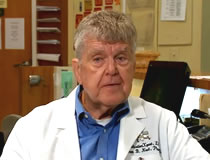March 30th, 2013
Equation May Give Wrong LDL Status
Equation May Give Wrong LDL Status
MedPage Today
Published: March 28, 2013
Reviewed by Robert Jasmer, MD; Associate Clinical Professor of Medicine, University of California, San Francisco and Dorothy Caputo, MA, BSN, RN, Nurse Planner
Action Points
The widely used Friedewald equation may be underestimating LDL cholesterol levels in many patients, a study found.
Note that 14.6% of the patients in the study were placed into different treatment groups by the Friedewald estimates and direct measurements, mainly due to classification in a lower LDL cholesterol treatment group by Friedewald compared with direct LDL cholesterol.
The widely used Friedewald equation may be underestimating LDL cholesterol levels in many patients, researchers found.
The discrepancy between LDL cholesterol values that were estimated by the Friedewald equation and those that were directly measured was greatest when LDL cholesterol levels were low and triglyceride levels were high, according to Seth Martin, MD, of Johns Hopkins Hospital, and colleagues.
Among patients with a Friedewald-estimated value of less than 70 mg/dL, for example, the directly measured level was a median of 9 mg/dL higher when triglycerides were 150 to 199 mg/dL and 18.4 mg/dL higher when triglycerides were 200 to 399 mg/dL, the researchers reported online in the Journal of the American College of Cardiology.
Overall, 14.6% of the patients included in the study were placed into different treatment groups by the Friedewald estimates and direct measurements. This discordance was mainly due to "classification in a lower LDL cholesterol treatment group by Friedewald compared with direct LDL cholesterol," which occurred in 11.3% of patients, they noted.
The discordance was greatest "when accuracy is most crucial, in patients with LDL cholesterol levels in the high-risk treatment range and concurrent hypertriglyceridemia," Martin and colleagues wrote, noting that because the Friedewald estimates were generally lower than the directly measured values, using the equation could result in undertreatment of high-risk patients.
"This phenomenon warrants consideration in contemporary patient care and clinical practice guidelines," the authors wrote.
With the Friedewald equation, LDL cholesterol is estimated by subtracting the HDL cholesterol level and the triglyceride level (divided by 5) from the total cholesterol level. Using the equation avoids the extra time and expense needed to directly measure LDL with ultracentrifugation.
Since the equation was introduced in 1972, however, practice guidelines have introduced lower LDL cholesterol targets, and high triglyceride levels have become more common due to the increasing problems of obesity, insulin resistance, and diabetes.
To assess the accuracy of the equation in a contemporary setting, the researchers compared Friedewald estimates with direct measurements performed with vertical density gradient ultracentrifugation by the Vertical Auto Profile (VAP) from 2009 to 2011.
After excluding the patients who had a triglyceride level of 400 mg/dL or greater -- in whom there are known limitations of the Friedewald equation -- the researchers examined data from 1,310,440 adults (mean age 59) who underwent lipid screening; 14.6% had a Friedewald-estimated LDL cholesterol level of less than 70 mg/dL, the treatment target for high-risk patients.
The median directly measured LDL cholesterol level was 109 mg/dL. Lipid distributions were similar to those seen in the National Health and Nutrition Examination Survey for 2007 to 2008, indicating that the study sample was nationally representative.
In general, the Friedewald estimates were lower than the direct measurements of LDL cholesterol, and the discordance was greatest among patients with low LDL cholesterol levels and high triglyceride levels.
Of the patients with a Friedewald estimate of less than 70 mg/dL, 23% had a direct measurement that was higher than that. That figure rose to 39% when triglycerides were 150 to 199 mg/dL and 59% when triglycerides were 200 to 399 mg/dL.
The findings could have implications for patient care, according to the researchers.
"While we are not suggesting the need for routine clinical measurement of LDL cholesterol by direct assays, it bears mentioning that multiple direct assays beyond the VAP test [used in this study] are available," they wrote.
"Nevertheless, non-HDL cholesterol and apolipoprotein B are alternative approaches, with potential advantages over any measure of LDL cholesterol, and these measures avoid confusion that arises in defining LDL cholesterol ...," they wrote. "Moreover, in clinical trial patients with LDL cholesterol levels in the high-risk range highlighted in our study, non-HDL cholesterol and apolipoprotein B were stronger markers of residual risk than Friedewald LDL cholesterol."
They acknowledged some limitations of the analysis, including the possibility that patients who undergo a VAP test may be a special population and the use of one-time LDL cholesterol measurements. In addition, the researchers did not have access to detailed clinical characteristics of the patients or clinical outcomes or information on statin use and fasting status before the lipid test.
While the cost of lipid testing was independent of the study, and the time of the investigators in conducting the study was not funded by Atherotech, the company provided valuable information that made this study possible, according to the researchers.
Martin reported that he had no conflicts of interest. His co-authors reported relationships with Abbott Laboratories, AstraZeneca, Atherotech, Merck & Co., Bristol-Myers Squibb, Daiichi Sankyo, Kaneka Pharma America, Takeda Pharmaceuticals, Kowa Pharmaceuticals, GlaxoSmithKline, Boehringer Ingelheim, LipoScience, Amarin Pharmaceuticals, Health Diagnostics Laboratory, Roche/Genentech, Essentialis, Arisaph, Aegerion, Amgen, Amylin, the University of Alabama in Birmingham, Pfizer, and Radiometer.
From the American Heart Association:
Secondary Prevention & Risk Reduction for Cardiac and Vascular Disease
AHA Science News from Sessions 2012: Novel Treatments for Managing Lipid disorders: the Rutherford Trial
Primary source: Journal of the American College of Cardiology
Source reference:
Martin S, et al "Friedewald estimated versus directly measured low-density lipoprotein cholesterol and treatment implications" J Am Coll Cardiol 2013; DOI: 10.1016/j.jacc.2013.01.079.
- June 17th, 2015
Some Heartburn Drugs May Boost Risk of Heart Attack, Study FindsRead - August 15th, 2014
Voluntary Recall: Peritoneal Dialysis SolutionRead - August 17th, 2014
Alcohol Intake and Atrial FibrillationRead - March 30th, 2014
CHANGES IN BLOOD PRESSURE PARAMETERS ???Read - January 7th, 2013
AHA Adds Its Weight to NSAID Risk MessageRead
Geriatric Nutrition
Without good nutrition, positive drug therapy outcomes are very difficult to obtain, For the best in Geriatric Nutritional Information
Find out more Optima SolutionsContinuing Education
Each month we will post an analysis of specific aspects of government long-term healthcare regulations.
Find out more


